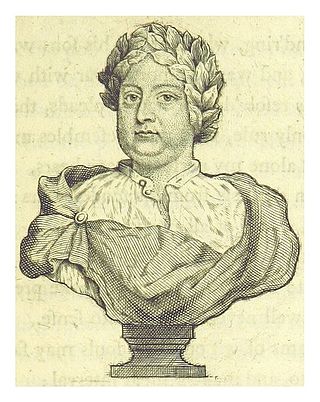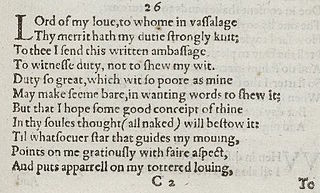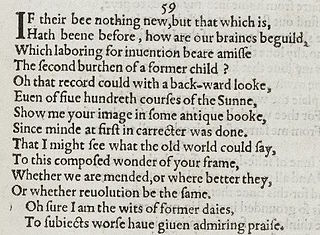
This article focuses on poetry from the United Kingdom written in the English language. The article does not cover poetry from other countries where the English language is spoken, including the Republic of Ireland after December 1922.

The term Metaphysical poets was coined by the critic Samuel Johnson to describe a loose group of 17th-century English poets whose work was characterised by the inventive use of conceits, and by a greater emphasis on the spoken rather than lyrical quality of their verse. These poets were not formally affiliated and few were highly regarded until 20th century attention established their importance.

William Lisle Bowles was an English priest, poet and critic.
An extended metaphor, also known as a conceit or sustained metaphor, is the use of a single metaphor or analogy at length in a work of literature. It differs from a mere metaphor in its length, and in having more than one single point of contact between the object described and the comparison used to describe it. These implications are repeatedly emphasized, discovered, rediscovered, and progressed in new ways.

Mac Flecknoe is a verse mock-heroic satire written by John Dryden. It is a direct attack on Thomas Shadwell, another prominent poet of the time. It opens with the lines:

This glossary of literary terms is a list of definitions of terms and concepts used in the discussion, classification, analysis, and criticism of all types of literature, such as poetry, novels, and picture books, as well as of grammar, syntax, and language techniques. For a more complete glossary of terms relating to poetry in particular, see Glossary of poetry terms.

Sonnet 18 is one of the best-known of the 154 sonnets written by English poet and playwright William Shakespeare.

Sonnet 130 is a sonnet by William Shakespeare, published in 1609 as one of his 154 sonnets. It mocks the conventions of the showy and flowery courtly sonnets in its realistic portrayal of his mistress.

Sonnet 55 is one of the 154 sonnets published in 1609 by the English playwright and poet William Shakespeare. It is included in what is referred to as the Fair Youth sequence.

Inspiration is an unconscious burst of creativity in a literary, musical, or visual art and other artistic endeavours. The concept has origins in both Hellenism and Hebraism. The Greeks believed that inspiration or "enthusiasm" came from the muses, as well as the gods Apollo and Dionysus. Similarly, in the Ancient Norse religions, inspiration derives from the gods, such as Odin. Inspiration is also a divine matter in Hebrew poetics. In the Book of Amos the prophet speaks of being overwhelmed by God's voice and compelled to speak. In Christianity, inspiration is a gift of the Holy Spirit.

Sonnet 26 is one of 154 sonnets written by the English playwright and poet William Shakespeare, and is a part of the Fair Youth sequence.

Shakespeare's Sonnet 33 is one of 154 sonnets written by the English playwright and poet William Shakespeare. It is a member of the Fair Youth sequence, in which the poet expresses his love towards a young man. This sonnet is the first of what are sometimes called the estrangement sonnets, numbers 33–36: poems concerned with the speaker's response to an unspecified "sensual fault" mentioned in (35) committed by his beloved.
Nationality words link to articles with information on the nation's poetry or literature.

Sonnet 57 is one of 154 sonnets written by the English playwright and poet William Shakespeare. It is a member of the Fair Youth sequence, in which the poet expresses his love towards a young man. Sonnet 57 is connected with Sonnet 58 which pursues the theme of the poet as a slave of the beloved.

Sonnet 59 is one of 154 sonnets written by the English playwright and poet William Shakespeare. It's a part of the Fair Youth sequence, in which the poet expresses his love towards a young man.
The volta is a rhetorical shift or dramatic change in thought and/or emotion. Turns are seen in all types of written poetry. In the last two decades, the volta has become conventionally used as a word for this, stemming supposedly from technique specific mostly to sonnets. Volta is not, in fact, a term used by many earlier critics when they address the idea of a turn in a poem, and they usually are not discussing the sonnet form. It is a common Italian word more often used of the idea of a time or an occasion than a turnabout or swerve.

Sonnet 133 is a poem in sonnet form written by William Shakespeare, first published in 1609 in Shakespeare's sonnets.

Sonnet 84 is one of 154 sonnets published by the English playwright and poet William Shakespeare in 1609. It's part of the Fair Youth sequence, and the seventh sonnet of the Rival Poet group.
Waṣf is an ancient style of Arabic poetry, which can be characterised as descriptive verse. The concept of waṣf was also borrowed into Persian, which developed its own rich poetic tradition in this mode.

"To Sheridan" or "To Richard Brinsley Sheridan" was written by Samuel Taylor Coleridge and published in the 29 January 1795 Morning Chronicle. As the last poem running as part of the Sonnets on Eminent Characters series, it describes Coleridge's appreciation of Richard Brinsley Sheridan and his theatre talents. Coleridge, unlike most, preferred Sheridan's somber works over his comedies and emphasizes them within the poem. Coleridge also respects Sheridan's political actions.















